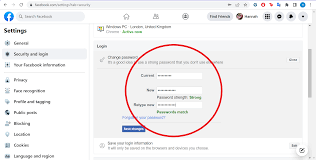6 Tips To Change Your Password on Your Computer

6 Tips To Change Your Password on Your Computer
If you’re like most people, you probably have the same password for all of your online accounts. While this might seem like a good way to keep track of everything, it’s actually not very secure. If one of your accounts is hacked, all of your others are vulnerable as well. That’s why it’s important to change your password regularly and to make sure that each password is unique. Here are six tips to change your password on your computer:
1. Choose a strong password. A strong password should be at least eight characters long and include a mix of upper and lowercase letters, numbers, and symbols. Avoid using easily guessed words like “password” or your name.
2. Change your passwords regularly. How often you need to change your passwords depends on how sensitive the information is that you’re protecting. As a general rule of thumb, though, you should change them every few months.
3. Don’t use the same password for multiple accounts. If one account is compromised, all of your others are at risk if you’re using the same password. Use different passwords for different sites and services.
4. Use a password manager if needed. If keeping track of multiple complex passwords sounds daunting, consider using a password manager like LastPass or 1Password. These tools will generate and store strong passwords for you so that you don’t have to remember them all yourself.
5 . Enable two-factor authentication when available. Two
windows OpenSSH
If you’re like most people, you probably won’t change your passwords very often. But if you’re using the same password for everything, you’re putting yourself at risk of being hacked. Here are six tips to help you change your passwords on your computer:
1. Use a password manager: A password manager can help you generate strong passwords and store them securely.
2. Use two-factor authentication: Two-factor authentication adds an extra layer of security by requiring you to enter a code from your phone or another device in addition to your password.
3. Use a different password for each account: If one of your accounts is hacked, the hacker will have access to all of your accounts if you’re using the same password. By using a different password for each account, you can limit the damage if one of your accounts is compromised.
4. Make your passwords long and strong: The longer and stronger your password is, the more difficult it will be for someone to guess or brute force their way into your account.
5. Use a mix of letters, numbers, and symbols: A mix of letters, numbers, and symbols make it even more difficult for someone to guess or brute force their way into your account.
6. Change your passwords regularly: Even if you follow all of the above tips, it’s still a good idea to change your passwords regularly to further reduce the risk of being hacked.

windows 7 password bypass
If you’re like most people, you have a password for your computer that you use to log in. But what happens if you forget your password? Or if someone else knows your password and you want to change it?
There are a few ways that you can bypass or change your password on Windows 7. Here are some tips:
1. If you forget your password, you can use a password reset disk. This is a disk that you create when you first set up your computer. It has information that can help you reset your password if you forget it.
2. You can also use the Safe Mode option to log in to your computer. Safe Mode is a way to start up your computer with only the most basic files and drivers. Once you’re in Safe Mode, you can change your password without having to enter your old one.
3. If someone else knows your password, you can change it by going to the Control Panel and clicking on User Accounts. Then, click on the account that you want to change and click Change the Password. Enter your new password twice and click Change Password.
4. You can also use a third-party software program to help you change or bypass your password. There are many different programs available, so make sure to do some research before choosing one.
5. If all else fails, you can always contact customer support for help. They may be able to help you reset your password or give you other
How to change your password on a Windows 7 computer
If you need to change your password on a Windows 7 computer, there are a few easy steps you can follow. First, click on the Start button and then select Control Panel from the menu. In the Control Panel, click on the User Accounts icon. Under the User Accounts section, click on Change your password. You will be prompted to enter your current password as well as a new password. Once you have entered both of these, click on the Change Password button to save your changes.
How to bypass a password on a Windows 7 computer
There are a few ways that you can bypass a password on a Windows 7 computer. One way is to use a password reset disk. If you have created one ahead of time, you can insert it into your computer and follow the prompts to reset your password. Another way is to use the Safe Mode option when booting up your computer. This will allow you to log in with an administrator account that has no password. Once you are logged in, you can change the password for your regular account.
How to reset your password on a Windows 7 computer
If you have forgotten your password, there are a few ways you can reset it. One way is to use a password reset disk. If you created one when you first set up your computer, insert it now and follow the instructions.
If you don’t have a password reset disk, you’ll need to use a different computer to create one. To do this, open the User Accounts control panel and click on Create a password reset disk in the left sidebar. Follow the instructions to create a bootable USB drive or CD that you can use to reset your password.
Once you have your password reset disk, insert it into your computer and restart. When prompted, enter your username and then click on Reset Password. Follow the instructions to enter a new password and confirm it. You should now be able to log in with your new password!
How to create a new password on a Windows 7 computer
1. Click on the Start Menu and then click on Control Panel.
2. In the Control Panel, click on User Accounts and Family Safety.
3. Under User Accounts, click on Change your password.
4. Enter your current password in the first field and then enter your new password in the second field.
5. Re-enter your new password in the third field to confirm it and then click on the Change Password button.
How to delete a password on a Windows 7 computer
If you need to delete a password on your Windows 7 computer, there are a few different ways you can do it. One way is to use the Control Panel. To do this, click on the Start menu and then type in “control panel” into the search box. Once the Control Panel appears, click on the “User Accounts” link. From here, you can click on the “Manage your credentials” link and then select the passwords that you want to delete.
Another way to delete passwords on your Windows 7 computer is by using the Command Prompt. To do this, click on the Start menu and type “cmd” into the search box. Once the Command Prompt appears, type in “net user username /delete” (without quotes). This will delete the specified user account from your computer.
How to edit a password on a Windows 7 computer
1. To change your password in Windows 7, open the Control Panel and click on User Accounts.
2. Click on the Change your password link under the User Accounts heading.
3. Enter your old password in the first field, then type your new password in the next two fields. Be sure to make it something you’ll remember!
4. Finally, click Change Password and you’re all set!
screen split windows
There are many reasons you might want to change your password on your computer. Maybe you’ve forgotten your current password, or maybe you simply want to choose a new, stronger password. Whatever the reason, changing your password is easy to do. Here are six tips to help make changing your password on your computer a breeze:
1. Choose a strong password. When choosing a new password, be sure to select something that is strong and difficult to guess. A strong password should be at least eight characters long and include a mix of upper and lowercase letters, numbers, and symbols.
2. Avoid using personal information. When choosing a new password, avoid using personal information such as your birthdate, address, or children’s names. These types of information can be easily guessed by hackers and should be avoided at all costs.
3. Change your password regularly. It’s important to change your password regularly, especially if you suspect that your account may have been compromised. By changing your password frequently, you can help prevent unauthorized access to your account and protect your personal information.
4. Use different passwords for different accounts. If you use the same password for multiple accounts, a hacker who gains access to one of your accounts will also have access to all of your other accounts. To help keep your accounts secure, be sure to use different passwords for each account you have.
